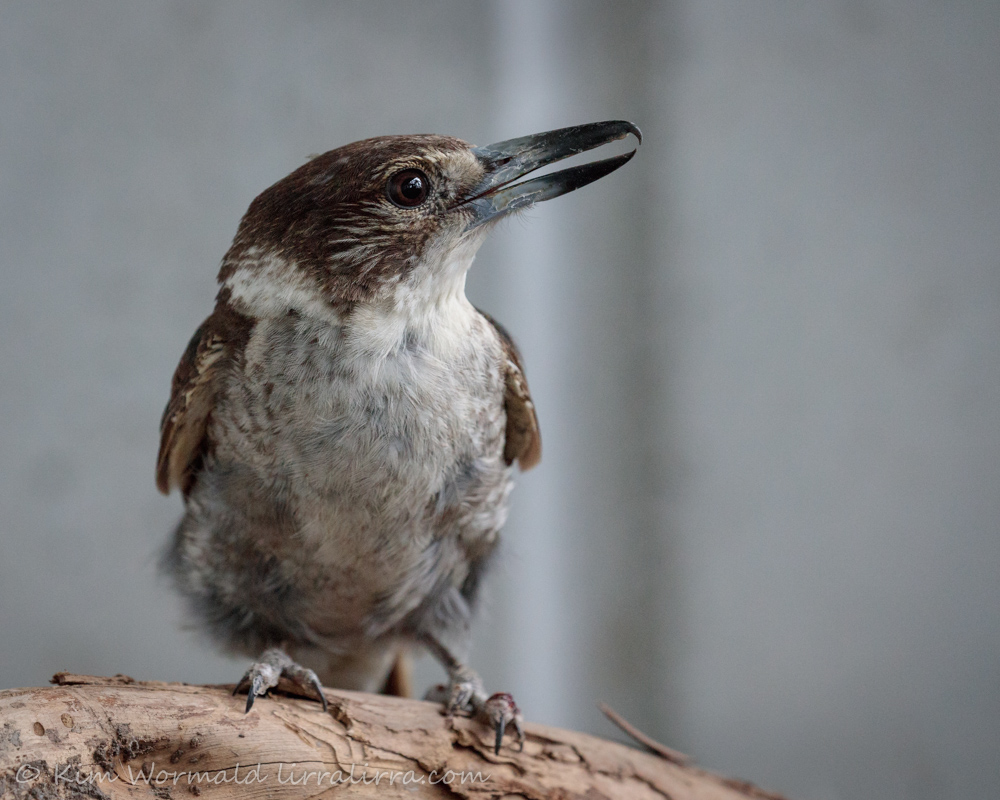Working on today’s post was delayed while I spent time using my camera to assess the well-being of this young Grey Butcherbird.
Grey Butcherbird (Cracticus torquatus) – injured
1/400, f/7.1, ISO 6400
I’m ambivalent about butcherbirds; they are beautiful birds with a fabulous song and they brilliantly do what nature intended them to do – which includes eating the small birds in my garden.
Over the past few months significant works have been done to the Melbourne Water retarding basin adjacent to our property. Much of the understorey was cleared during the works which removed habitat used by small birds and affected the livelihood of the butcherbirds. Grey Butcherbirds are often heard in and around my garden but since the works they have become permanent residents, successfully raising two offspring.
This young bird became trapped in our woodshed. Luckily the woodshed started its life as an aviary for housing injured wildlife so has a partially wired front and the butcherbird could be seen flying back and forth. The nictictating membrane of its right eye seemed to be across that eye more often than normal. I slipped into the woodshed, after draping my fabric hide over the door, and bent down low in a corner. The butcherbird seemed calmer with me in the cage than it had been when I was outside, perhaps because I’d reduced the area it was comfortable to fly in.
It was overcast this afternoon and the lighting inside the shed, beneath the huge Mahogany Gums (Eucalyptus botryoides), was dismal. I needed to use ISO 6400 and even that only gave me a shutter speed of 1/400th of a second. As I was so close to the bird I needed to widen the depth of field as much as possible by using f/7.1.
The photographs confirmed my concern about an injury to its eye. In the image above you may be able to see a slightly lighter area at 9 o’clock on its iris that I think is an abrasion. I hadn’t realised until looking at the images on the desktop that the poor bird has also injured its left foot; that injury can also be seen in the image above.
Many years ago I looked after a young Grey Butcherbird, that for some strange reason had been named Enzo. It was a gorgeous, noisy little character that fledged perfectly and was released where it had been found. Today’s bird didn’t make a sound. Until a week or so ago the butcherbird fledglings were still spending time with the parents but there was no sign of the parent birds today. Maybe if this bird had called they would have been lurking nearby, or maybe they were and I just couldn’t see them.
Once inside the shed I could see that Enzo 2 must have got in at ground level where a burrowing critter of some kind (probably a rabbit) had scraped a hollow. As butcherbirds catch much of their prey on the ground we’re guessing that it was following a mouse.
I called friends who operate wildlife shelters and decided it would be best to leave the bird in the woodshed tonight, with a bowl of water, and get it properly assessed in the morning.
Happy birding, Kim
PS you may have noticed that the butcherbird’s scientific name includes the same genus as the magpie in last week’s post, they are closely related
~ thank you for visiting and commenting
~ if you would like to join the subscribers who receive a weekly email letting them know when lirralirra has been updated please use the ‘subscribe’ box above right
Exhibition extended until this weekend! Many images are still displayed in the gallery and a sample will remain available from the Mont de Lancey gift shop.
Where: Mont de Lancey Historic Homestead, 71 Wellington Road, Wandin North 03 5964 2088
When: until Sunday 11 December 2016 – open Wednesdays to Sundays, 10am – 4pm


I do hope this little guy has made a full recovery.
All was good Ann
I love this photo. So lovely
Could I paint it please?
A…
I just looked you up online Ann and your artwork is exquisite. You capture the detail and dynamic nature of the birds so beautifully. You may paint this butcherbird, could you send me a photograph of your finished work?
Great photo Kim and sometime you need to share with us a video of your garden. It always amazes me how the people doing all this “clearing” forget about all the small critters that use the understory for protections.
That’s so true about ‘clearing’, especially when hollows are vital to so many of our species. I don’t think I’d be very good at taking a video, I tried one of the exhibition and it’s full of wobbles and reflections.
Such an interesting beak! I hope it will be ok and can be released somewhere away from your wrens!
Yes, yes, yes!
I do hope it is ok.
I have a soft spot for them and unlike humans they don’t hunt for ‘fun’.
I just realised, when new messages arrived, that I hadn’t answered your comment. The butcherbird was fine